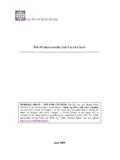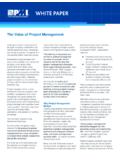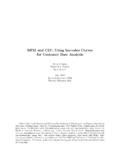Transcription of Higher Heating Value and Lower Heating Value Variation …
1 Higher Heating Value and Lower Heating Value Variation prepared by: James E. Houck and Jeremy Clark OMNI Environmental Services, Inc. 13327 NE Airport Way Portland, OR 97230 November 11, 2009 Summary The heat content of wood fuel is necessary for efficiency calculations as well as for air emission reporting when the reporting convention is based on the mass of pollutant emitted per unit of heat delivered. There are three common ways of defining Lower Heating values (LHV) and several methods for measuring the heat content of fuel, including ASTM D5865 and ASTM E711 as specified in section of draft standard (August 29, 2009). OMNI split a sample of Douglas fir fuel and submitted it to two laboratories, one using method D5865 and one using E711. Values were then calculated for each of the three different Lower Heating Value conventions. The variability in results is shown in Table 1. For comparison the Lower Heating values calculated from default Value (HHV) from B415 are also shown in Table 1.
2 Table 1 Heating Values 1 ASTM D 5865-07a: Standard Test Method for Gross Calorific Value of Coal and Coke 2 ASTM E 711-87: Standard Test Method for Gross Calorific Value of Refuse-Derived Fuel by the Bomb Calorimeter 3 : Performance Testing of Solid-Fuel-Burning Heating Appliances 4 calculated per ASTM D 5865 5 by electrical resistance moisture meter per EPA Method 28; converted to dry basis 6 D. Bushnell, et al., Biomass fuel characterization: Testing and evaluating the combustion characteristics of selected biomass fuels, OSU 1989. Lab A Huffman Labs (ASTM D 58651) Lab B Twin Ports Testing (ASTM E 7112) B4153 Default Values As Received Moisture FreeAs Received Moisture Free HHV @ constant V 7854 Btu/lb 8747 Btu/lb 6845 Btu/lb 8036 Btu/lb 8516 Btu/lb HHV @ constant P4 7853 Btu/lb 8746 Btu/lb 6843 Btu/lb 8034 Btu/lb 8513 Btu/lb Moisture (dry basis)5 LHV1 7276 Btu/lb 8223 Btu/lb 6368 Btu/lb 7476 Btu/lb 7869 Btu/lb LHV2 7039 Btu/lb 7985 Btu/lb 6130 Btu/lb 7238 Btu/lb 7639 Btu/lb LHV3 6870 Btu/lb 7817 Btu/lb 5962 Btu/lb 7070 Btu/lb 7467 Btu/lb Carbon (wt.)
3 %) Hydrogen (wt. %) Nitrogen (wt. %) Oxygen (wt. %) Note: Split samples of Douglas Fir were sent to two laboratories. The latest draft of CSA states, The calorific Value of a representative sample of the fuel to be used in each appliance test series shall be determined in accordance with ASTM Standards D6865 or E711. LHV1 accounts for the vaporization of H2O formed during combustion. LHV2 accounts for combustion H2O and the vaporization of free H2O. LHV3 accounts for combustion H2O, the vaporization of free H2O, and the conversion of bound H2O to free H2O. Sample Effect on Efficiency: By the previous version of B415, LHV2 would be used. For the dry sample from Lab A, LHV2 = 7985 Btu/lb If an appliance were determined to have a 75% efficiency, then = x / (7985 Btu/lb) x = 5989 Btu/lb Using the revised B415 and LHV3, Efficiency = (5989 Btu/lb) / (7070 Btu/lb) * 100% = 85% Sample Calculations Converting HHV at constant volume to HHV at constant pressure.
4 From ASTM D 5865, the energy associated with the change in volume of the gaseous phase for the combustion reaction may be expressed as Qv-p = * RT * (Had / (2* ) Oad / Nad / ) where R = J/(mol*K) T = K Had = as-determined % hydrogen in the analysis sample, excluding sample moisture Oad = as-determined % oxygen in the analysis sample Nad = as-determined % nitrogen in the analysis sample So for the moisture free sample analyzed by Lab B, Qv-p = * J/(mol*K) * K * ( / ( g/mol) / ( g/mol) / ( g/mol) = J/g = J/g * ( g*Btu) / ( lb*J) = Btu/lb = Btu/lb = Qv-p = 8036 Btu/lb Btu/lb = 8034 Btu/lb Calculating LHV1: Since LHV1 = HHV energy needed to vaporize combustion H2O, then LHV1 = hvap * (Had) * (molar ratio of H2O to H) where hvap = heat of vaporization of water at 25 C = 43985 J/mol = Btu/lb So for the moisture free sample analyzed by Lab B, LHV1 = 8034 Btu/lb Btu/lb * ( ) * ( / ) = 7476 Btu/lb Calculating LHV2: Since LHV2 = HHV energy needed to vaporize combustion H2O energy needed to vaporize free H2O, then LHV2 = LHV1 hvap * (%Mdb / 100) where %Mdb = percent moisture of the wood sample on a dry basis So for the moisture free sample analyzed by Lab B, LHV2 = 7476 Btu/lb Btu/lb * ( / 100) = 7238 Btu/lb Calculating LHV3.)
5 Since LHV3 = HHV energy needed to vaporize combustion H2O energy needed to vaporize free H2O energy needed to convert bound H2O to free H2O, then LHV3 = LHV2 Qbw where Qbw = energy required to bring bound water to the energy level of free water = MRbw * { (1 / %Mwb) * [ * %Mwb * (%Mwb)2 + * (%Mwb)3 + * (%Mwb)4 * (%Mwb)5 + * (%Mwb)6 * (%Mwb)7]} and MRbw = mass rate of bound water in lb/s %Mwb = percent moisture of the wood sample on a wet basis = (%Mdb / (%Mdb + 100)) * 100% So for the moisture free sample analyzed by Lab B, MRbw = 1 lb/s (assumed Value ) %Mwb = ( / ( + 100)) * 100% = Simplifying Qbw leads to Qbw = * %Mwb + * (%Mwb)2 + * (%Mwb)3 * (%Mwb)4 + * (%Mwb)5 * (%Mwb)6 = * + * ( )2 + * ( )3 * ( )4 + * ( )5 * ( )6 = Therefore LHV3 = 7238 Btu/lb Btu/lb = 7070 Btu/lb







